View in other NatureServe Network Field Guides
NatureServe
Montana
Utah
Wyoming
Idaho
Wisconsin
British Columbia
South Carolina
Yukon
California
New York
Woollypod Milkvetch - Astragalus purshii var. concinnus
Native Species
Global Rank:
G5T3T4
State Rank:
S3S4
(see State Rank Reason below)
C-value:
Agency Status
USFWS:
USFS:
BLM:
External Links
State Rank Reason (see State Rank above)
Astragalus purshii variety concinnus occurs primarily in southwestern Montana and adjacent central-east Idaho. Occurrences are scattered throughout its southwestern Montana range with about half the observations found between 1888-1960 and half between 1976-2014. Plants do not appear limited by habitat requirements, but current data on population sizes, locations, and threats is greatly needed to accurately assess its status in Montana.
- Details on Status Ranking and Review
Range Extent
ScoreE - 5,000-20,000 sq km (~2,000-8,000 sq mi)
Comment11, 550 square kilometers
Area of Occupancy
ScoreD - 6-25 4-km2 grid cells
CommentPlant occurs in 19 of the 30,590 4x4 square-kilometer grid cells that cover Montana.
Number of Populations
ScoreC - 21 - 80
Commentat least 19 observations
Number of Occurrences or Percent Area with Good Viability / Ecological Integrity
Comment3 observations assumed to be of good viability based on descriptor of 'common'.
General Description
PLANTS: A short, perennial forb from a branched caudex. The nearly leafless stems (acaulescent) are prostrate, 5–10 cm, clothed in stipules. Herbage is wooly-villous which gives the plant a silvery-grey appearance
LEAVES: Pinnately compound leaves are about 12 cm long, weakly ascending or erect. The 9-13 leaflets are oval-orbicular, oblanceolate to lanceolate with rounded to acute tips. Stipules are lanceolate, 3–10 mm long, and separate from each other.
INFLORESCENCE: A short, tightly congested raceme that appears somewhat umbellate-like and terminates a leafless peduncle, usually less than 10 cm long. The inflorescence of 3-10 flowers is erect, about as tall as the leaves, but often lays on the ground in fruit. Flowers are 18-25 mm long. Petals are either
dull white except for the purple tinged keel tip (seldom is the banner and wing tips lavender) or magenta. The banner petal is 18–25 mm long and moderately reflexed. The keel petal is 15–20 mm long. Sepals are 2–5 mm long with black and/or white villous hairs>
Montana’s plants are of variety purshii or concinnus.
Sources: Lesica et. al 2012; Giblin et al. [eds.] 2018.
Diagnostic Characteristics
In Montana
Astragalus purshii has two varieties (Lesica et al. 2012):
*
var. concinnus has magenta flowers (petals) that are 18-20 mm long. Legumes are curved. It is mostly found in the sagebrush steppe of the montane zone within southwest Montana.
*
var. purshii has creamy-white to pale lavendar flowers (petals) that are 18-25 mm long. The legumes are nearly straight. It is found in grasslands and sagebrush steppe in the plains and valley zones of Montana.
Species Range
Montana Range
Range Descriptions

 Native
Native
Range Comments
A regional endemic of central and east-central ID and southwestern MT (Kartesz 2009).
Observations in Montana Natural Heritage Program Database
Number of Observations: 19
(Click on the following maps and charts to see full sized version)
Map Help and Descriptions
Relative Density
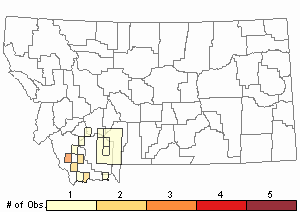
Recency
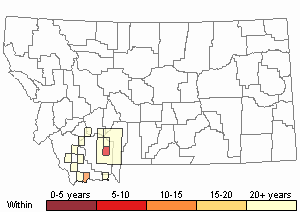
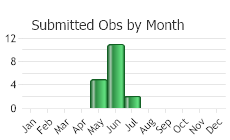
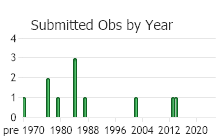
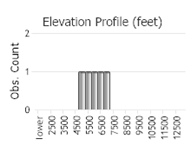 (Observations spanning multiple months or years are excluded from time charts)
(Observations spanning multiple months or years are excluded from time charts)
Habitat
Var. concinnus is mostly found in the sagebrush steppe of the montane zone within southwest Montana.
Ecology
POLLINATORS The following animal species have been reported as pollinators of this plant species or its genus where their geographic ranges overlap:
Bombus vagans,
Bombus appositus,
Bombus auricomus,
Bombus bifarius,
Bombus borealis,
Bombus centralis,
Bombus fervidus,
Bombus flavifrons,
Bombus huntii,
Bombus mixtus,
Bombus nevadensis,
Bombus rufocinctus,
Bombus ternarius,
Bombus terricola,
Bombus occidentalis,
Bombus pensylvanicus,
Bombus griseocollis, and
Bombus insularis (Macior 1974, Thorp et al. 1983, Mayer et al. 2000, Colla and Dumesh 2010, Wilson et al. 2010, Koch et al. 2012, Miller-Struttmann and Galen 2014, Williams et al. 2014).
Reproductive Characteristics
FRUIT [Source: Lesica et al. 2012]
The ovary has dense, long, and soft hairs. The legume is 12-25 mm long, retains the dense long hairs, and is tipped with a sharp beak. The legume is also narrowly ovoid (compressed perpendicular to the septum) in shape.
Stewardship Responsibility
References
- Literature Cited AboveLegend:
 View Online Publication
View Online Publication Colla, S.R. and S. Dumesh. 2010. The bumble bees of southern Ontario: notes on natural history and distribution. Journal of the Entomological Society of Ontario 141:39-68.
Colla, S.R. and S. Dumesh. 2010. The bumble bees of southern Ontario: notes on natural history and distribution. Journal of the Entomological Society of Ontario 141:39-68. Koch, J., J. Strange, and P. Williams. 2012. Bumble bees of the western United States. Washington, DC: USDA Forest Service, Pollinator Partnership. 143 p.
Koch, J., J. Strange, and P. Williams. 2012. Bumble bees of the western United States. Washington, DC: USDA Forest Service, Pollinator Partnership. 143 p. Lesica, P., M.T. Lavin, and P.F. Stickney. 2012. Manual of Montana Vascular Plants. Fort Worth, TX: BRIT Press. viii + 771 p.
Lesica, P., M.T. Lavin, and P.F. Stickney. 2012. Manual of Montana Vascular Plants. Fort Worth, TX: BRIT Press. viii + 771 p. Macior, L.M. 1974. Pollination ecology of the Front Range of the Colorado Rocky Mountains. Melanderia 15: 1-59.
Macior, L.M. 1974. Pollination ecology of the Front Range of the Colorado Rocky Mountains. Melanderia 15: 1-59. Mayer, D.F., E.R. Miliczky, B.F. Finnigan, and C.A. Johnson. 2000. The bee fauna (Hymenoptera: Apoidea) of southeastern Washington. Journal of the Entomological Society of British Columbia 97: 25-31.
Mayer, D.F., E.R. Miliczky, B.F. Finnigan, and C.A. Johnson. 2000. The bee fauna (Hymenoptera: Apoidea) of southeastern Washington. Journal of the Entomological Society of British Columbia 97: 25-31. Miller-Struttmann, N.E. and C. Galen. 2014. High-altitude multi-taskers: bumble bee food plant use broadens along an altitudinal productivity gradient. Oecologia 176:1033-1045.
Miller-Struttmann, N.E. and C. Galen. 2014. High-altitude multi-taskers: bumble bee food plant use broadens along an altitudinal productivity gradient. Oecologia 176:1033-1045. Thorp, R.W., D.S. Horning, and L.L. Dunning. 1983. Bumble bees and cuckoo bumble bees of California (Hymenoptera: Apidae). Bulletin of the California Insect Survey 23:1-79.
Thorp, R.W., D.S. Horning, and L.L. Dunning. 1983. Bumble bees and cuckoo bumble bees of California (Hymenoptera: Apidae). Bulletin of the California Insect Survey 23:1-79. Williams, P., R. Thorp, L. Richardson, and S. Colla. 2014. Bumble Bees of North America. Princeton, NJ: Princeton University Press. 208 p.
Williams, P., R. Thorp, L. Richardson, and S. Colla. 2014. Bumble Bees of North America. Princeton, NJ: Princeton University Press. 208 p. Wilson, J.S., L.E. Wilson, L.D. Loftis, and T. Griswold. 2010. The montane bee fauna of north central Washington, USA, with floral associations. Western North American Naturalist 70(2): 198-207.
Wilson, J.S., L.E. Wilson, L.D. Loftis, and T. Griswold. 2010. The montane bee fauna of north central Washington, USA, with floral associations. Western North American Naturalist 70(2): 198-207.
- Additional ReferencesLegend:
 View Online Publication
View Online Publication
Do you know of a citation we're missing? Lesica, P., M.T. Lavin, and P.F. Stickney. 2022. Manual of Montana Vascular Plants, Second Edition. Fort Worth, TX: BRIT Press. viii + 779 p.
Lesica, P., M.T. Lavin, and P.F. Stickney. 2022. Manual of Montana Vascular Plants, Second Edition. Fort Worth, TX: BRIT Press. viii + 779 p.
- Web Search Engines for Articles on "Woollypod Milkvetch"





